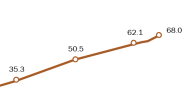The analysis of this report is based on asylum application data from Eurostat, the European Union’s statistical agency. Eurostat is a central repository of the European Union’s economic, environmental and population data. Its goal is to provide high quality statistics that enable comparisons across countries.
Annual data were accessed on June 22, 2016. The asylum application by year files (2008 to 2015, first-time applications only) and (1985 to 2007, all applications) were used for annual estimates.
Data showing the origins, destinations, sex and age of asylum seekers between 2008 and 2015 use a standardized set of definitions for asylum seekers. Also, EU legislation on processing asylum seekers has become more consistent across member states in recent years. Consequently, data since 2008 are considered reliable and consistent across countries and years. There is a small chance that individual asylum seekers are recorded multiple times within and across European countries. But, these situations are rare because of centralized databases (EURODAC), used by EU member states in recent years. The analysis of data since 2008 in this report assumes that each case in the data file represents an individual person and is based on first-time applicants only, not appeals or asylum seekers applying again.
Data of asylum seekers between 1985 and 2007, however, are not consistent across countries and years. Countries voluntarily reported asylum applications to Eurostat before 2008 and did so in different ways. Some countries during these years, for example, counted a household as a single application, even though several individuals may be on one application. This way of counting would present a lower number of applicants seeking asylum. In the other direction, some countries counted application appeals in their total numbers of asylum seekers. This type of double counting would inflate the number of individuals seeking asylum. Unfortunately, it is unclear whether these two biases on how individual applicants are counted cancel each other out.
Consistent with previous publications produced by Eurostat on asylum seekers, application estimates between 1985 and 2007 are based on the total origins of asylum seekers, and therefore do not include detailed information about places of origin, only destinations. 4 Data for destination countries with the largest volume of asylum seekers (Belgium, France, Germany, the Netherlands, Spain, Sweden and the UK) are available for most years.
A small share of data since 2008 (less than 5% for most years and countries) have unknown origins of asylum seekers. Also a small share of data since 2008 (again less than 5% for most years and member states) contain unknown gender and age of asylum seekers. These unknown cases were included in the calculations of percentages throughout the report, except where specified by footnotes.
Estimates presented in this report are rounded to the nearest thousand, except for per capita estimates which are rounded to the nearest ten. Although exact counts are available from Eurostat, there is the potential for numbers to be slightly incorrect as underlying data may consist of some provisional estimates or incomplete data. Percentages are also rounded to whole numbers for the same reason. Percentages were rounded from unrounded estimates.




